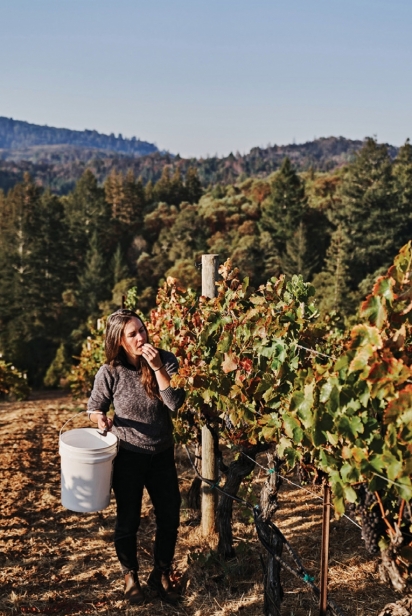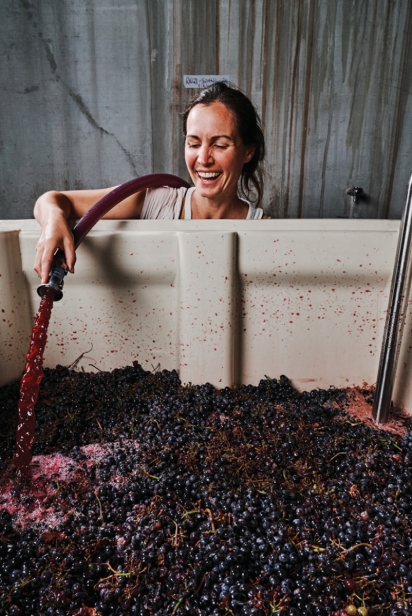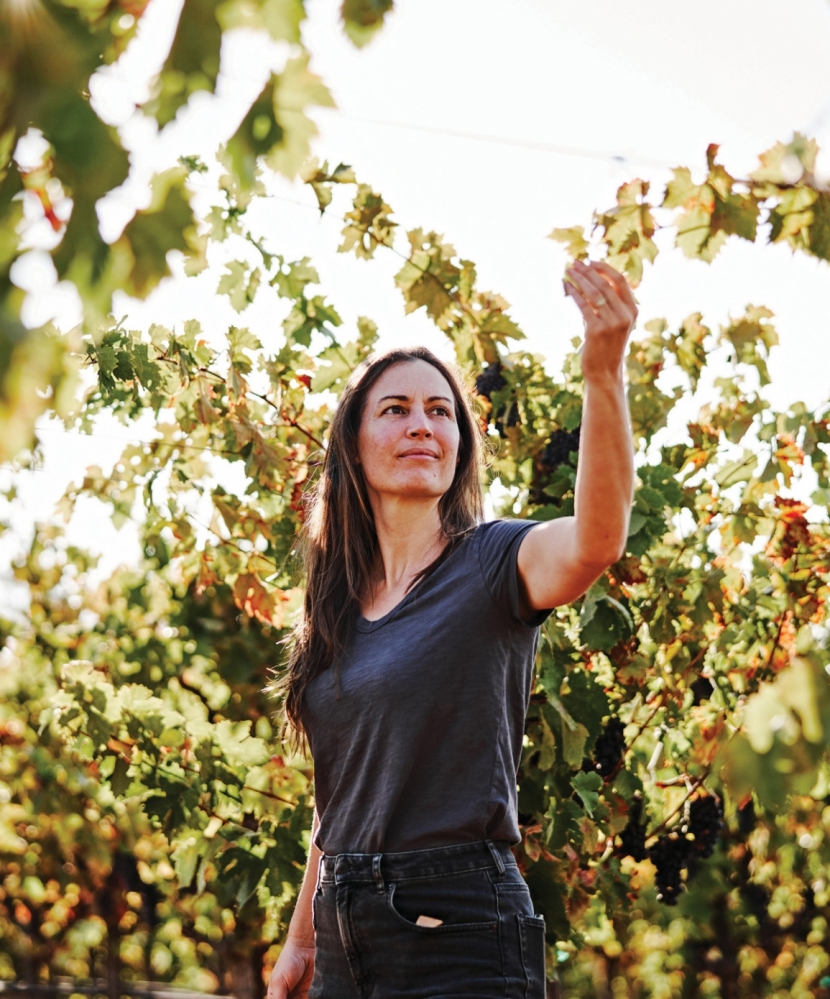Winemaker Martha Stoumen- A Decade of Natural Winemaking in Sonoma County
FOR a bootstrapping winemaker, Northern California might seem a daunting place to settle. The costs of land, rent, labor, equipment and fruit are all exorbitantly high and the climate is becoming unpredictable at best, dangerous at worst. Despite these challenges, a growing group of visionary winemakers have taken root here. For them, what the region lacks in affordability and resources it makes up for in community and collaboration.
Off the touristed plazas of Sonoma and Napa lie hubs of collaborative winemaking, like Pax Winery in Sebastopol’s Barlow, home to a rotating cast of winemakers. Humming with a ballet of fruit deliveries and fermentations each harvest season, spaces like these make up the core of the region’s thriving natural wine scene. This scene is a diverse one, including novice winemakers embarking on their first or second vintage and established forces like Martha Stoumen, a Sebastopol native who bottled the 10th vintage of her eponymous label this past fall.
To mark this momentous occasion we sat down to chat about the state of the natural wine movement today. While she extolled the virtues of making natural wine here, the issue of vineyard succession and a tumultuous climate means an unpredictable future for herself and her peers.
If you live in Northern California, in the past decade you’ve likely encountered natural wine: a growing movement that has the tendency to be misunderstood, in part because it’s difficult to define. Stoumen lays out her definition as follows: “Natural wines are made from organically or biodynamically farmed vineyards—certified or not—and fermented and aged with no additives. Some, like myself, add very small amounts of sulfites prior to bottling, with a total SO<sup>2</sup> usually under ~35 ppm. The idea behind adopting these processes is to translate, without obscuring, the characteristics of a given site or territory.”
After graduating from college, a call to work in agriculture coupled with a desire to discover her ancestral home soon brought Martha to Italy. In 2006 she embarked on her first of many apprenticeships, helping make wine and tend a vineyard at Tenuta di Spannocchia in Siena. It was love at first vineyard, and Stoumen went on to work a series of harvest internships around the globe, at wineries like Heymann Löwenstein in the Mosel, that were employing natural winemaking processes but not yet naming them as such.
Back stateside, Martha enrolled at UC Davis Enology School. It was there, circa 2010, that she first encountered the term natural wine, when friend and classmate Junichi Fujita shared two wines from Sicily, made by COS & Frank Cornelissen respectively. Enamored by COS, after receiving her degree from Davis Martha took off for Sicily to work as their harvest assistant and later, stateside, as their brand ambassador.
Upon her return, Martha continued her tutelage working under Chris Brockway at his pioneering Berkeley winery Broc Cellars. Following this gig and the many that had come before it, Martha was eager to launch her own label. Many thought this unwise but she remained optimistic; it was clear to Martha the natural wine movement would continue to grow.
“To me, [launching a natural wine label] did not feel that risky at all. It was the most interesting way for me to make wine [at that moment.] The reason I got into winemaking wasn’t to formulate something … If that was the point I would have gone into food science or … making soda.”
After establishing her label in Berkeley, Martha soon returned home and began working out of Pax, the facility where she remains to this day. “I’m proud to be making wine in my home county,” Martha declares. Though not without its challenges, Sonoma County has proven an idyllic, community-oriented backdrop. “People here are open minded [and] environmentally minded,” she says.
The Perks: Earth-centric, Community-Focused and Rural
As a native, Martha doesn’t take for granted the unique education available here. “Going to grade school [in Sonoma] you learn about gardening and recycling and what produce is in season when.” These touchpoints have proven useful to Martha as she’s had to rely on buy-in from an audience who cares about the earth just as much as she does.
Beyond environmental consciousness, Sonoma and its neighboring counties have proven a useful place to make natural wine due to their removal from the metropolis. To country-dwellers, this may seem surprising but a recent query amongst the global natural wine cognoscenti is: Has natural wine gotten too big? In effect, has the trendiness of this movement overshadowed the environmental, political and social causes that birthed it?
Martha believes this line of questioning isn’t entirely relevant here: Sonoma County is “bucolic and not caught up in any large scene or trend.” As Martha sees it, “it takes so long to grow grapes…” Nature’s timeline doesn’t sync up with the trend cycle so she can’t be bothered to keep up.
Beyond bucolic, making natural wine in Sonoma is extremely collaborative. Martha’s career here has been built on community-mindedness and creative collaboration. While she could afford to eventually relocate to a winery of her own, the prospect sounds lonely.
Up against economic pressure and the high cost of all things needed to make wine, local natural winemakers have come to rely on and revel in shared resources. Whether that’s sharing a facility, trading equipment, sharing tasting rooms or collaborating on events, the cooperation seems endless. According to Martha, “there are more opportunities [to collaborate] that come our way than we can handle.”
A prime example is Martha’s residency last summer at Little Saint, Healdsburg’s sprawling wine shop, restaurant and venue. Little Saint sommelier Alexandria Sarovich and Martha got to talking at an event and the idea of a pop-up was quickly born. Alexandria and the team at Little Saint had so much beautiful space to fill, Martha had no public-facing tasting room and was eager to provide a venue where she could feature her wines and interface with customers. The residency was a huge success and a testament to the ways in which collaborative efforts materialize here.
While Martha doesn’t plan to open a tasting room anytime soon, she says to keep eyes peeled for pop-ups, wine dinners and bar takeovers at Sebastopol spots like The Redwood and Piala.
The Challenges: Climate Change & Vineyard Succession
Advantages aside, making natural wine in Sonoma County is not without its challenges. Natural winemakers rarely own their own land and are up against extreme commercial pressure, climate crises and the looming question of vineyard succession. While this past harvest season was practically perfect thanks to copious rains, no fires and all-around wonderful weather, Martha knows better than to expect the same in years to come.
“The weather is going to be pretty yo-yo going forward. I hope this doesn’t scare people away from making natural wine [here].” While there’s an argument to be made for natural wine being more challenging in the face of climate crises, Martha prefers a glass-half-full attitude.
“It’s more liberating to make natural wine in a climate crisis world. Natural winemakers make the best wine from what they have available.” Martha and her peers have a certain amount of flexibility to change what they bottle, and less pressure to deliver the same staid product year after year.
Natural winemakers who own vineyards here are few and far between. Like many of her neighboring natural winemakers, Martha sources the majority of her fruit from organic vineyards in Mendocino County. The reason for this outsourcing is manifold: Less mildew and disease pressure makes it easier to farm organically there, plus cheaper land and labor costs drive down the cost of fruit. Working with growers in Mendocino has been a valuable aspect of making wine here but what will happen once they retire keeps Martha up at night.
“All of the farmers [we work with] are older and their children aren’t going to take over the grape growing.” While a solution remains unclear, Martha hopes to focus attention towards solving this problem of succession in the coming years. Her ideas include establishing a land trust, pursuing collective ownership of vineyards or introducing a patron model where passionate natural wine consumers step in to purchase land and keep these vineyards in play. Martha’s hope is to come up with a solution that ensures the landmark organic vineyards serving the natural wine community are protected for years to come.
Martha’s career provides a paradigm of natural wine’s proliferation in Northern California. From a bright-eyed entrepreneur inspired to make wine in a way that honors the earth, to a seasoned leader with realistic expectations and concerns, her trajectory proves that natural wine has come of age and is here to stay. In this bucolic region, tucked away from the city, natural winemakers will continue to collaborate, innovate and bootstrap as long as grapes continue to grow. Despite climate change and the lingering question of land succession, Martha continues to grow her brand and support the movement at large. It will be a joy to see where she takes Martha Stoumen wines in the decade to come.








